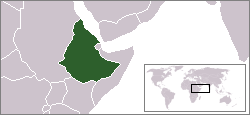Ethiopian Empire
| |||||||||||||||||||||||||||||||||||||
The Ethiopian Empire, also known as Abyssinia, in what is now Ethiopia and Eritrea existed from approximately 1270 (beginning of Solomonid Dynasty) until 1974 when the monarchy was overthrown in a coup d'etat. It was in its time the oldest state in the world[citation needed], and the only native African nation to successfully resist the Scramble for Africa by the colonial powers during the 19th century.
Early History
Human settlement in Ethiopia is very ancient with earliest ancestors to the human species discovered. Together with Eritrea and the southeastern part of the Red Sea coast of Sudan, it is considered the most likely location of the land known to the ancient Egyptians as Punt whose first mention dates to the 25th century B.C.E. The beginnings of a state were evident in the area that would become Abyssinia by 980 B.C.E., which also serves as its legendary date of establishment. This date may have more to do with dynastic lineage than the actual establishment of a state.
Zagwe Dynasty
The history of independent Abyssinia begins with the death of the last Aksumite king and overlord at the hands of the founder of the Zagwe Dynasty. This occurred around 1137. The Zagwe were of the Agaw dynasty, whose power never extended much farther than their own ethnic heartland. Nevertheless, they continued the Christianity of Aksum and constructed many magnificent churches such as those at Lalibela. The dynasty would last until its overthrow by a new regime claiming descent from the old Aksumite kings.
Solomonid Dynasty
In 1270, the Zagwe dynasty was overthrown by a king claiming lineage with the Aksumite emperors and thus that of Solomon (hence the name "Solomonid"). The Solomonid Dynasty was born of and ruled by the Habesha, from whom Abyssinia gets its name.
The Habesha reigned with only a few interruptions from 1270 until the late 20th century. It is under this dynasty that most of Ethiopia's modern history is formed. During this time, the empire conquered and incorporated virtually all the peoples within modern Ethiopia and Eritrea. They successfully fought off Arab and Turkish armies and made fruitful contacts with some European powers.
Scramble for Africa and Modernization
The 1880s were marked by the Scramble for Africa and modernization of Ethiopia. Conflicts with Italy resulted in the Battle of Adowa in 1896, whereby the Ethiopians surprised the world by defeating the colonial power and remaining independent under the rule of Menelik II. Italy and Ethiopia signed a provisional treaty of peace on October 26, 1896.
Italian Invasion and WWII
In 1935 Italian soldiers commanded by Marshal Emilio De Bono invaded Ethiopia. The war lasted seven months before an Italian victory was declared. The invasion was condemned by the League of Nations, though as with the Manchuria Incident, not much was done to end the hostility. Ethiopia became part of Italian East Africa until its liberation in 1941 by Allied forces in North Africa.
Ethiopia received Eritrea after World War II, which remained within it after the dissolution of the monarchy until Eritrea's separation in 1993.
Rise of Derg
In 1974 a pro-Soviet Marxist-Leninist military junta, the "Derg", led by Mengistu Haile Mariam, deposed Haile Selassie and established a one-party communist state. Haile Selassie was imprisoned and died under unclear circumstances, possibly because of being denied medical treatment.
See also
- History of Ethiopia
- Zagwe Dynasty
- Aksumite Empire
- Solomonid Dynasty
- History of Ethiopia (1270 - 1527)|First Solomonic period (1270–1527)
- Invasion of Gragn (1527–1543)
- Great Oromo migration (1543–17th c.)
- Ottoman Invasion (1557–17th c.)
- Gondarine dynasty (1606–1755)
- Zemene Mesafint (1755–1855)
- Modernization (1855–1936)
- Second Italo-Abyssinian War (1935–1936)
- Italian East Africa (1936–1941)
- East African Campaign (World War II) (1941)
- Italian guerrilla war in Ethiopia (1941–1943)
- Second Modernization (1941–1974)
- Eritrean War of Independence (1961–1991)
- Ethiopian Civil War (1974–1991)
- Rulers and heads of state of Ethiopia
- Army of the Ethiopian Empire
- Kingdoms and Provinces of the Ethiopian Empire
id:Kekaisaran Ethiopia it:Impero d'Etiopia he:האימפריה האתיופית ko:에티오피아 제국 nl:Keizerrijk Ethiopië pt:Império Etíope
Credits
New World Encyclopedia writers and editors rewrote and completed the Wikipedia article in accordance with New World Encyclopedia standards. This article abides by terms of the Creative Commons CC-by-sa 3.0 License (CC-by-sa), which may be used and disseminated with proper attribution. Credit is due under the terms of this license that can reference both the New World Encyclopedia contributors and the selfless volunteer contributors of the Wikimedia Foundation. To cite this article click here for a list of acceptable citing formats.The history of earlier contributions by wikipedians is accessible to researchers here:
The history of this article since it was imported to New World Encyclopedia:
Note: Some restrictions may apply to use of individual images which are separately licensed.

